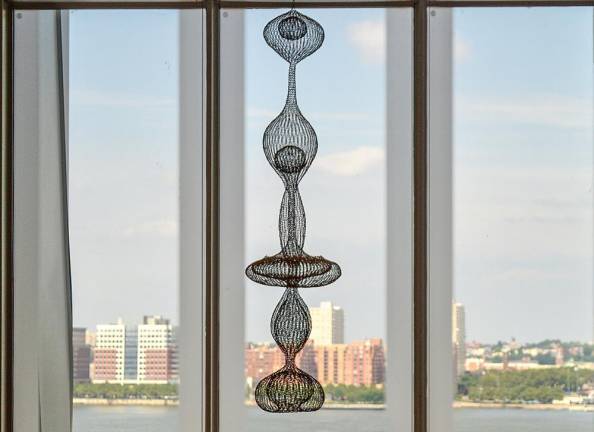A Line Can Go Anywhere
Meet a Masterpiece by Ruth Asawa

Since last summer, I’ve been posting letters with beautiful Ruth Asawa stamps. Like many art lovers, I read with eager anticipation the announcement that the U.S. Postal Service had chosen to honor this great artist, and I pre-ordered a large supply. The stamps present ten of her unique wire sculptures – undulating, graceful forms reminiscent of flowers, raindrops, shells, or underwater kelp fields. They became instant bestsellers. You can’t get them anymore, except through collectors.
How ironic it is that Asawa (1926-2013) a celebrated sculptor, born and raised in America, began her arts education in an internment camp when she, her mother, and siblings were incarcerated in 1942. Her father had been taken earlier to a separate camp. The country had declared war on Japan, and these hardscrabble farmers were deemed a possible threat.
But it was in the camp that she met a group of Asian-American artists whose vision is now embedded in our cultural DNA – illustrators at Walt Disney responsible for the look of “Snow White” and “Pinocchio.” They mentored her, shared their meager supplies, and encouraged her artistic curiosity. It was the beginning of a path that would lead her to Black Mountain College and the classroom of Josef Albers, with the likes of Willem and Elaine de Kooning, Robert Rauschenberg, Merce Cunningham and Buckminster Fuller.
“Untitled (S.270, Hanging Six-Lobed, Complex Interlocking Continuous Form within a Form with Two Interior Spheres)” is an unusual title for a work, but there’s nothing usual about this masterpiece of the Whitney Museum’s collection, currently on view on the sixth floor. Asawa’s sculpture is now, as it was in 1955 when she made it, radical, original, exquisitely wrought and unlike anything else.
Sculptures are supposed to be hefty and imposing as they sit on immovable plinths. They speak of solidity, importance and permanence. Asawa’s wire sculptures are airy – almost weightless – as they dangle from above. With the passing of a viewer or a rush of air from an open door, they move. Like all sculptures, they celebrate form, but hers enclose forms within forms, spheres within ovals, leading to other squat, tubular or pendulous curvilinear shapes. Filled with the kinds of repetitions and undulations of nature, they hint at impermanence and the very different value that imposes.
Negative Space
“Untitled, S.270” is three-dimensional but almost devoid of mass. It embodies sophisticated modern concepts like repetition, focus on material, and negative space, even while its lines and shapes hover like hummingbirds, bend like grasses, and swirl like galaxies. All of which makes sense when you know that they started with a cactus.
“A friend of ours brought a desert plant from Death Valley and said, ‘Here’s something for you to draw.’ I tried to draw it, but it was such a tangle that I had to construct it in wire in order to draw it. And then I got the idea that I could use it as a way to work in wire. I began to see all the possibilities,” said Asawa. She learned the technique from women in rural Mexico who wove wire egg baskets, and finally found her form. With wire, she could accomplish complex drawings she’d been reaching for since childhood when she etched wiggly lines in the ground with her feet.
In the 1950s, her works were purchased by the Museum of Modern Art, the Rockefeller family, and influential collectors. By the 60s and 70s, the fame that found other women artists of her time had passed Asawa by. She continued to create, but poured much of her energy into civic involvement and arts education, giving back to her California community. Ruth Asawa was an educator, an activist, a wife and mother, the first generation of her lineage born in the United States and the first in her family to attend college. Her story includes art and museums, but other than that, it’s quintessentially American, identical to so many of ours and our parents’.
“An artist is not special. An artist is an ordinary person who can take ordinary things and make them special,” said Asawa, who never spoke of resenting internment. “Sometimes good comes through adversity. I would not be who I am today had it not been for the internment, and I like who I am.”
Like all of ours, her path had obstacles, but she transcended them. “A line,” Asawa once said, “can go anywhere.”
“An artist is not special. An artist is an ordinary person who can take ordinary things and make them special.” Sculptor Ruth Asawa